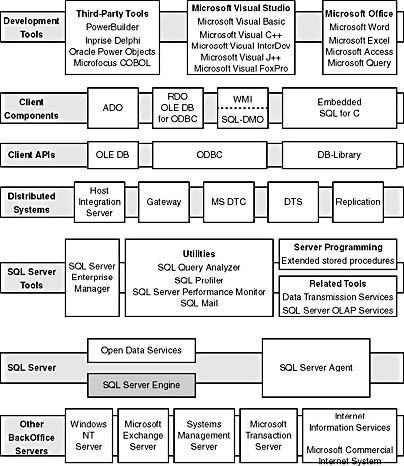Chapter 2 -- A Tour of SQL Server
Chapter 2
Microsoft SQL Server 2000 is a high-performance client/server relational database management system (RDBMS). It was designed to support high-volume transaction processing (such as that for online order entry, inventory, accounting, or manufacturing) as well as data warehousing and decision-support applications (such as sales analysis applications). SQL Server 2000 runs on Microsoft Windows NT 4 or Microsoft Windows 2000 Server-based networks using Intel processors an d can be installed as a personal desktop database system on machines running Windows NT Workstation 4, Windows 2000 Professional, Windows 98, and Windows Millennium Edition (Me). You can use the same CD to install one of the Server versions or the Personal version of SQL Server 2000. In addition, you can install multiple instances of SQL Server 2000 on the same computer, each with its own set of users and its own data. (I'll cover the details of multiple instances in Chapter 4.)
SQL Server 2000 actually has seven different editions available on different CDs: Standard Edition, Enterprise Edition, Personal Edition, Developer Edition, Windows CE Edition, Evaluation Edition, and Microsoft Desktop Engine (MSDE). (I'll discuss the differences between the editions in Chapter 4.)
NOTE
To simplify operating system designations, I'll use the following conventions. Windows NT/2000 means any of the following operating systems that support SQL Server 2000: Windows NT Server 4, Windows NT Server 4, Enterprise Edition, Windows NT Workstation 4, Windows 2000 Server, Windows 2000 Advanced Server, Windows 2000 Professional, or Windows 2000 Datacenter Server. If I need to refer specifically to just the server platforms, I'll use the designation Windows NT/2000 Server, which means any of the operating systems listed above except Windows NT Workstation 4 and Windows 2000 Professional. To refer to just the non-server operating systems, I'll use Windows NT/2000 Workstation. The designation Windows 98 includes both Windows 98 and Windows Me.
SQL Server 2000 also provides many client tools and networking interfaces for other Microsoft operating systems, such as Windows 3.1 and MS-DOS. And because of SQL Server's open architecture, other systems (such as UNIX-based systems) can also interoperate with it. SQL Server is part of the core of a family of integrated products that includes development tools, systems management tools, distributed system components, and open development interfaces, as shown in Figure 2-1. It's also a key part of Microsoft BackOffice.

Figure 2-1. The SQL Server family of integrated components.
Most of this book focuses on the capabilities and uses of the SQL Server engine; this chapter provides an overview of the SQL Server family of components and describes the features and benefits of each component. Understanding these features and benefits will be helpful to you as you develop applications.
EAN: 2147483647
Pages: 179